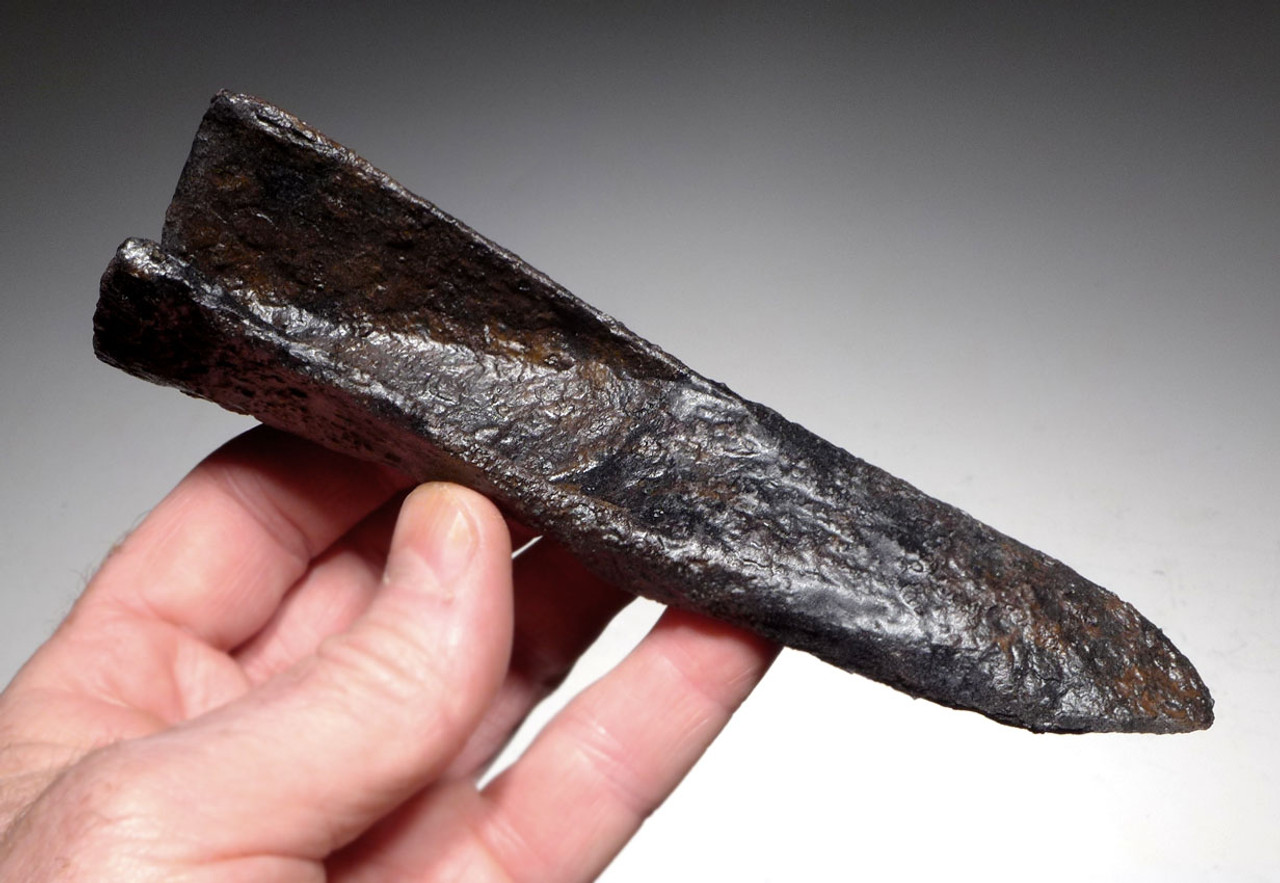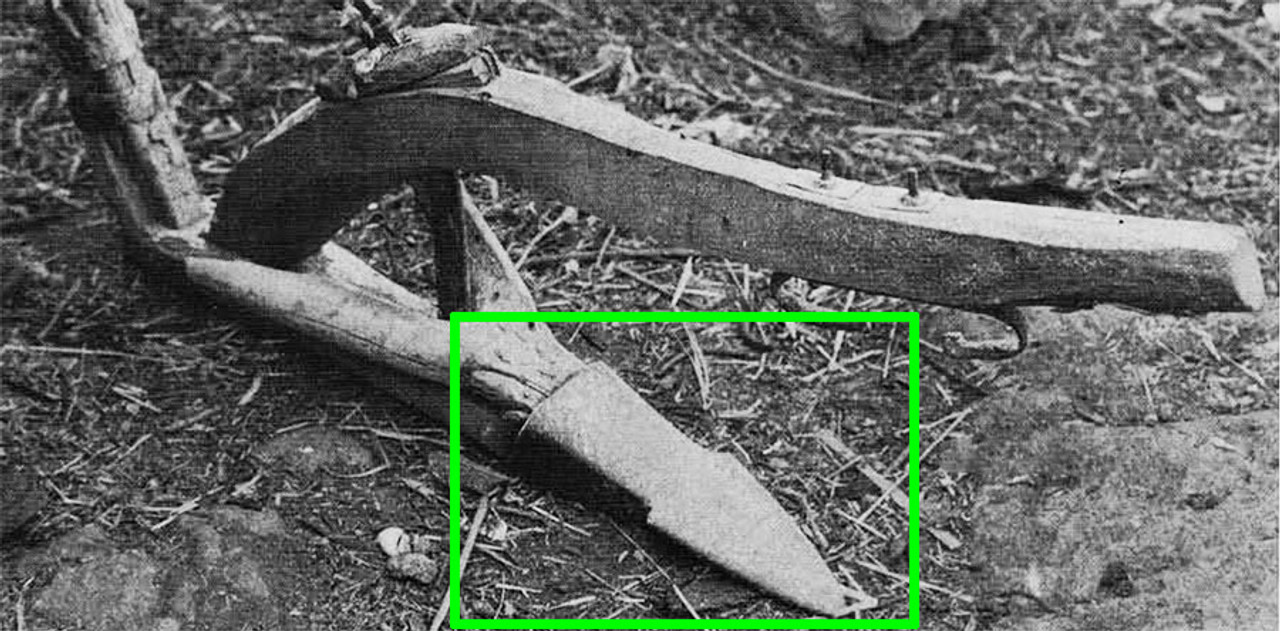Product Description
With the sheer scarcity of genuine ancient Celtic artifacts on the market, this offering is a special opportunity. It is a rare artifact of ancient farming - an iron plowshare from an ard plow (scratch plow). The plowshare is complete with dense preservation to its surface. Originally found in Germany, ancient Celtic iron rarely survives the elements and complete specimens are very rare. Laws in Europe have forbade any modern discoveries for several decades making the acquisition of these rare objects only possible from private collections that pre-date local restrictions, as this one has come from.
The ard, ard plough (scratch plough), is a simple light plough without a mouldboard. In its simplest form it resembles a hoe, consisting of a draft-pole (either composite or a single piece) pierced with a nearly vertical, wooden, spiked head (or stock) which is dragged through the soil by draft animals and very rarely by people. The ard-head is at one end a stilt (handle) for steering and at the other a share (cutting blade) which gouges the surface ground. It began to be replaced in China by the heavy carruca turnplough in the 1st century AD, and in most of Europe from the 7th century AD.
Ards were used by the Celts to plow fields. Unlike modern plows, which turn over the soil, ards only broke it up. Double plowing in opposite directions was therefore necessary, and criss-cross patterns made by ancient farmers are visible in aerial photographs of Iron Age settlements.
Unlike most metal artifacts sold on the market that are untreated and uncleaned, our specimens our properly cleaned, inspected and conserved in our museum conservation lab prior to being offered for sale to our clients. If ancient metal is NOT treated and stabilized correctly, IT WILL CONTINUE TO DISINTEGRATE AND CORRODE, AND COULD EVENTUALLY FALL APART INTO PIECES.
SEE MORE ANCIENT CELTIC ARTIFACTS
HISTORY
Around 2000 B.C., barbarian Celtic tribes invaded Europe. They first inhabited regions across Eastern Europe now known as Hungary, Bulgaria, Romania and the Balkans. During the Bronze Age, they move westward and by the Iron Age in the 8th to 5th centuries BC, these tribes make their homes in what is now southwest Germany, eastern France and parts of Switzerland and Austria. This era is known as the Hallstatt period named after a Celtic archaeological type-site in a lakeside village in Austria. After that, in the La Tene period, western Europe becomes heavily occupied by the Celts as they invade much of Germany, France, the Iberian Peninsula (Spain and Portugal), the British Islands and Ireland. After this time, Celtic tribes spread eastward again, moving into northern Italy, Bohemia, Silesia, the Balkans and even into present day Turkey with a tribe called the Galatians establishing a Celtic city called Galatia. During the 1st century BC, the Celts were at the height of their power and were the dominant ethnic group in much of Europe, even ruling over the Germanic tribes. Among the many military victories the ancient Celts can lay claim to are the sacking of the cities of Rome and Delphi.
The Celts were largely a decentralized military aristocracy made up of independent chieftains ruling various geographical regions. They were famous to fight just for the sake of fighting and often, they were employed as mercenaries of the great armies of ancient times. Along with their reputations of chivalry, courage and maniacal bravery, their more aggressive tendencies were offset by a great sensitivity to the arts and philosophy. Highly unusual at the time, the Celts viewed both men AND women with equality, holding women in high regard with their matriarchal religion.
One of the famous works the Celts were known for was their masterful works in metal-smithing. Spectacular works can be found all over Europe left behind by Celtic masters in gold, silver, bronze and later, in iron. Much of the influence of Bronze Age European metal ornament lends itself to the influence Celtic master craftspeople.
WARNING: There is an ALARMING number of fake and altered ancient artifacts on the market. As fine quality intact, original specimens become more scarce and techniques have become more sophisticated to fake these artifacts. We have personally handled numerous extremely well-done fakes with convincing patinas that could fool most people. The degree to which the fakers have been able to replicate patina to disguise their work requires an expert examination by highly experienced individuals. Like all rare collectibles, fakes plague the market. We subject every piece we offer to a full analysis, cleaning and conservation process in our on-site lab. How many dealers do this or have any experience in operating their own lab? The procedures we put each piece through are the same as we do for those specimens destined for museums and the same procedures as the best museums perform on their own collections. Deal only with sources that are extremely knowledgeable in forgeries or altered pieces and get a written guarantee of authenticity that has no conditions or expiration period. We include this guarantee in writing with every item we sell. All purchases should include from the dealer, a written guarantee of authenticity with unconditional and lifetime return policies regarding such guarantee.
 US DOLLAR
US DOLLAR
 EURO
EURO
 AUSTRALIAN DOLLAR
AUSTRALIAN DOLLAR
 CANADIAN DOLLAR
CANADIAN DOLLAR
 POUND STERLING
POUND STERLING














